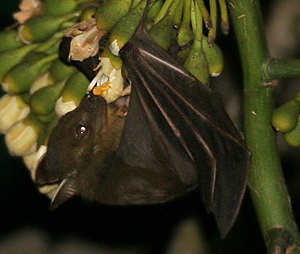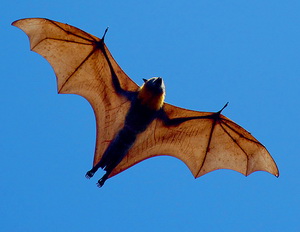Page Visit Log : thai_bats
» Thai Bats
| Learn Thai | Thai Beaches | Thai Festivals | Thai Baht Rates | Thai Weather | Thai Recipes | Thai Music | Thai Tales | Thai Visa??? | Bangkok Maps |
If you have any questions on bats in Thailand why not post them on our Thai Animals Forum.
If you enjoyed this page then you are sure to enjoy our pages on Wild Cats of Thailand, Thai Mongoose, Thai Turtles, Thai Terrapins, Thai Snakes, Tokay Gecko, Thai Civets, Thai Crocodiles, Water Monitor Lizard, Thai Fish, Thai Ducks, Hornbills, Birds of Prey, Thai Langurs, Thai Primates, Fence Lizard, Thai Scorpions, Thai Centipedes, Thai Butterflies, Thai Ants, Thai Hornets or the Rhino Beetle.Thai Bats
Greater Short-nosed Fruit Bat

Science Name : Cynopterus sphinx
General Characteristics : These bats have a relatively long snout. Their upper parts are brown to grey-brown with paler under parts. The fur is very fine and silky. The ears and wing bones of C.sphinx are edged in white. Lower cheek teeth rounded without accessory cusps. The wing span of the adult is about 48 cm. Juveniles are lighter than adults. Average forearm length 70.2mm (64-79mm).
Habitat / Food : C.sphinx is common in tropical forests and areas where fruit crops are cultivated. They can also be found in grassland and mangrove forests.
They typically nest high in palm trees. The bats chew the fronds of the palms to construct fairly simple tents. These bats are also known to construct tents by closely interweaving the leaves and twigs of creeping vines which cover buildings, but such nests are constructed only when palms are not available.
These bats are frugivorous, locate their preferred food items by scent. They have been described as voracious feeders, eating more than their body weight in food in one sitting. Some preferred fruits include ripe guava, banana, chikoo, dates and lychees.
Behavior / Mating : The species is gregarious, and typically roosts in same sex groups of 8-9 individuals. The sexes remain separate until the mating season, when group size increases. They are polygynous and it is usual for 6-10 males and 10-15 females to share palm frond tents during the breeding season.
Copulation by males is dorsoventral and the females lick the shaft or the base of the male's penis, but not the glans which has already penetrated the vagina.
While the females do this, the penis is not withdrawn and research has shown a positive relationship between length of the time that the penis is licked and the duration of copulation.
Post copulation genital grooming has also been observed. Males stay with females for some time after mating, but later return to same sex groups.
Current Status : Classified as non-endangered.
Flying Fox

Science Name : Pteropus giganteus
General Characteristics : Dark brown, gray, or black body color with a contrasting yellowish mantle is typical of the genus Pteropus. Body mass ranges from 600 to 1600 g and males are generally larger than females. Wingspan may range from 1.2 to 1.5 m and body length averages 23 cm.
Members of the genus Pteropus maintain body temperatures between 33 and 37 C, but must do this through constant activity.
Habitat / Food : Found throughout Thailand. These animals can be found in forests and swamps. Large groups of individuals roost in trees such as banyan, fig, and tamarind. Roosting trees are usually in the vicinity of a body of water. This species has been reported to eat many different species of fruit, including guava, mango, and fig. An individual of the genus Pteropus squeezes out fruit juices from the pulp against the roof of its mouth, and then discards the dry material. Some Pteropus species also supplement their dietary protein by eating insects.
Behavior / Mating : Pteropus giganteus is a social species, with large groups of several hundred individuals living in the same tree. Males may maintain a vertical dominance hierarchy of resting spots in the tree, and may also defend the roost and associated females from intruders.
During the day, these animals sleep, hanging upside down by their feet with their wings wrapped around themselves. They also fan themselves to aid in thermoregulation, move around in the roosting tree, and communicate with each other. As they are nocturnal, they leave the tree at sunset to feed, returning after several hours of finding food, feeding, digesting, and resting. Pteropus giganteus breeds yearly, with mating occurring from July to October, and births occurring from February to May.
To initiate copulation, a male will fan his wings toward a female, and persistently follow her until he is able to grip the scruff of her neck with his teeth and hold her with his thumbs. Copulation occurs for a duration of 30 to 40 seconds. The female usually vocalizes and physically resists the advances of the male during the encounter. After copulation, the male again follows the female while vocalizing loudly.
Gestation period is typically 140 to 150 days, after which 1 to 2 young are born. Like other members of the genus Pteropus, the young are carried by the mother for the first few weeks of life. Sexual maturity for this species occurs at about 1.5 years of age.
Current Status : Classified as non-endangered.
Painted Bat

Science Name : Kerivoula picta
General Characteristics : Colors for Kerivoula picta are bright orange or scarlet, with black wings and orange along the fingers. As in other forms of Kerivoula, K. picta possesses long, wooly, rather curly hair, a small, fragile form, large funnel-shaped ears and 38 teeth.
Head and body length is 31-57mm. Tail length is 32-55 mm, and forearm length is 27-45 mm.
Habitat / Food : Found throughout Thailand. Kerivoula picta often roost in tree hollows and trunks, foliage, huts, and buildings, but also inhabit dry leaves of vines and other plants, plantain fronds, and flowers. Feeds on insects of all types.
Behavior / Mating : Painted bats forage late in the evening and generally fly in circles close to the ground with a weak, fluttering flight. They roost solitarily or in groups of 2-6 bats. Little is know of their mating habits.
Current Status : Classified as non-endangered.
Wrinkle Lipped Bat

Science Name : Tadarida plicata
General Characteristics : The wrinkle lipped bat has a relatively small skull, with an extra-small upper premolar. The upper part of its body is covered with short brown fur, and its underparts are paler with gray tips to the fur. Its upper lip is heavily wrinkled, and it has large, round, forward-pointing ears that are joined across the top of its head by a narrow flap of skin. This species has piglike nostrils. Known as a free-tailed bat, the wrinkled-lipped bat is distinguished by a thick tail that protrudes from the membrane stretching between its legs.
Habitat / Food : Found throughout Thailand. They roost in caves in large, densely packed colonies, which sometimes contain thousands of individuals.
Wrinkle lipped bats eat insects, mostly moths, which they hunt in midair.
Behavior / Mating : They roost during the day and forage at night; they usually exit their caves before darkness falls in dense flocks. Night foraging protects them from predators, sun and high temperatures. They hunt prey and navigate in the dark using echolocation. They tend to nest near the entrance of caves. Most mating activity occurs over a period of a few weeks; females generally bear one offspring. Infants are often blind and deaf for a short period of time after birth. Wrinkle lipped bats may live as long as 20 years, due to their isolated roosts, nocturnal activity and colonial way of life.
Current Status : Classified as non-endangered.


